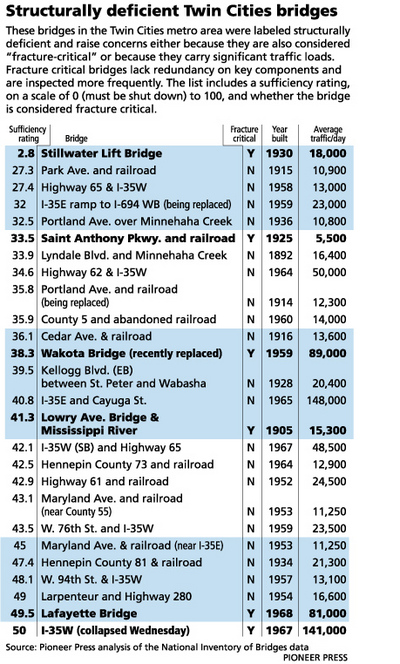Chad the Elder at Fraters Libertas beat me to posting about an editorial in the Wall Street Journal the absurdity and hypocrisy of those using the cantilevered ruins of the 35W bridge as a springboard to call for higher gas taxes.
Minnesota’s transportation auditors warned as long ago as 1990 that there was a “backlog of bridges that are classified as having structural deficiencies.” In 1999 engineers declared that cracks found in the bridge that collapsed were “a major concern.” Bike paths were deemed a higher priority by Congress, however, including its powerful Minnesota Representatives.
As recently as July 25, Mr. Oberstar sent out a press release boasting that he had “secured more than $12 million in funding” for his state in a recent federal transportation and housing bill. But $10 million of that was dedicated to a commuter rail line, $250,000 for the “Isanti Bike/Walk Trail,” $200,000 to bus services in Duluth, and $150,000 for the Mesabi Academy of Kidspeace in Buhl. None of it went for bridge repair.
Minnesota’s state budget is also hardly short of tax revenue. The state spends $25 billion a year, twice what it did 10 years ago. The Tax Foundation reports that Minnesota has the seventh highest personal income tax rates among all states, the third highest corporate tax rates, and the 10th highest taxes on workers.
The Legislature started the year with a record $2 billion budget surplus, and the economy threw off another $149 million of unexpected revenue. Where did all that money go? Not to roads and bridges. The Taxpayers League of Minnesota says the politicians chose to pour those tax dollars into more spending for health care, art centers, sports stadiums and welfare benefits.
Even transportation dollars aren’t scarce. Minnesota spends $1.6 billion a year on transportation — enough to build a new bridge over the Mississippi River every four months. But nearly $1 billion of that has been diverted from road and bridge repair to the state’s light rail network that has a negligible impact on traffic congestion. Last year part of a sales tax revenue stream that is supposed to be dedicated for road and bridge construction was re-routed to mass transit. The Minnesota Department of Economic Development reports that only 2.8% of the state’s commuters ride buses or rail to get to work, but these projects get up to 25% of the funding.
Americans aren’t selfish or stingy, and they can see for themselves that many of our roads need repair. Minnesota in particular is a state that has long prided itself on its “progressive” politics and a willingness to pay higher taxes for good government. Minnesotans already pay twice as much in taxes per capita than residents in New Hampshire and Texas — states that haven’t had a major bridge collapse.
We don’t lack the money in Minnesota to do what needs to be done, and should have been done. What we lack are the political leaders on both sides with the vision and guts to serve the public and not their pet interest groups. The money problem isn’t that there’s not enough to do the job but that it’s misused and abused to buy votes — whether it’s state money diverted to boondoggles or the money the special interests pour in to fit lovely gold rings into the noses of the politicians.












